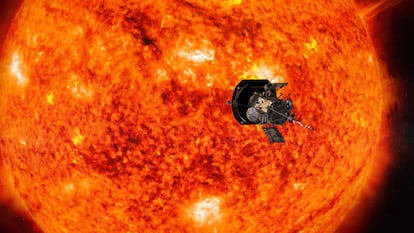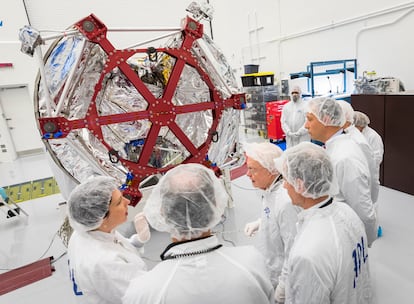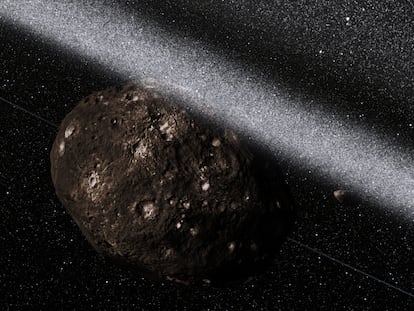‘Parker Solar,’ the fastest spacecraft in history, will come within 3.8 million miles of the Sun
NASA’s probe will enter the star’s atmosphere on Christmas Eve, making the closest pass ever of the Sun’s surface, to try to unravel the mystery of why it is so much hotter than its surface

Since the Parker Solar Probe (PSP) was launched into space in 2018, it has successfully completed a series of feats. In 2021, it became the first spacecraft to “touch the Sun” by flying through its corona without being melted by the devastating temperatures: it then spent several hours in its atmosphere. A year later, it withstood a colossal solar flare, and last November, it flew past Venus without disintegrating, adjusting its final orbital trajectory. This event will enable Parker to come within just over 3.8 million miles (6.1 million kilometers) of the surface of our star on Tuesday, which is almost twice as close as it managed three years ago.
On Christmas Eve, at 12:48 p.m. GMT, the probe will reach a speed of 429,989 mph (692,000 km/h) as it approaches solar maximum, the phase of greatest activity of the Sun, which occurs every 11 years. This encounter is consecrated as one of the greatest milestones of the space race, says Teresa Nieves Chinchilla, a Spanish heliophysicist and scientific director at NASA of another mission, the Solar Orbiter, which investigates the star’s electromagnetic field. “The Parker Solar is the fastest object that humans have ever built. There isn’t enough fuel to take the ships to great distances, so what we did was use the gravitational assist of Venus to modify the trajectory,” this expert from NASA’s Goddard Space Flight Center, who has been studying the Solar System’s primary star for two decades, tells EL PAÍS from Washington, D.C.
The spacecraft was launched on August 12, 2018. From Earth, which is located at an average distance of 150 million kilometers from the Sun, it has been traveling around our cosmic neighborhood, gradually approaching the star and collecting measurements and images of its behavior, using instruments such as an antenna and several magnetometers. The purpose of the mission is to decipher why some layers of the solar atmosphere can reach temperatures of millions of degrees, while the visible surface — the photosphere — is estimated to be about 5,000ºC. On this occasion, Parker Solar will once again fly over the corona, the outermost layer of the solar atmosphere composed of plasma. Although this is the closest distance to the Sun that an object launched into space by humans has ever reached, six million kilometers is — on the scale of our planet — a huge distance: 15 times greater than the distance that separates the Moon from the Earth.
This part of its structure is much hotter than the surface of the Sun, a mystery that the scientific community hopes to solve in this unprecedented encounter. The field of view of the telescopes that try to illuminate this question from Earth — in observatories such as those in Hawaii, Chile, and the Canary Islands — is quite limited because it is in the visible range. The chromosphere and the corona emit a light that can only be observed and studied properly during a solar eclipse, when the Moon passes between the Sun and our planet. “We use that information to have that puzzle of knowledge of how the Sun is a source of radiation, how it affects our magnetosphere, and how it would influence the future of human exploration,” explains Nieves Chinchilla.

Future missions to Mars and the Moon
Understanding the behavior of the star’s layers is crucial to deciphering the origin and evolution of the solar wind. Solar storms can be a threat to astronauts, cause damage to power lines, and interfere with satellite communications on our planet. “This has occupied science for decades and that thread was one of the reasons we wanted to reach the Sun,” says the scientist.
The solar storm last May, for example, not only affected Earth, but also Mars. According to Nieves Chinchilla, the radiation that an astronaut would have received would have been equivalent to 30 X-rays. “We want to avoid this, because although it is not fatal, it is harmful. To make these predictions, we need to know how the Sun works,” she says. The mission — together with the NASA-European Space Agency’s Solar Orbiter, which is researching the poles — is important for planning future space travel, such as the Artemis program, which has recently suffered a fresh delay (NASA no longer expects a human being to set foot on the Moon before 2027) and the possible manned mission to Mars in the 2030s.
With this historic encounter, the Parker will have completed 24 orbits of the Sun and this will be the first of several successive approaches that it will make up to June 2025, during the final phase of the mission. The project and the spacecraft are named after Eugene Parker (1927-2022), an American astrophysicist who revolutionized the study of the Sun and developed a series of theories about the solar wind and stars.
Sign up for our weekly newsletter to get more English-language news coverage from EL PAÍS USA Edition
Tu suscripción se está usando en otro dispositivo
¿Quieres añadir otro usuario a tu suscripción?
Si continúas leyendo en este dispositivo, no se podrá leer en el otro.
FlechaTu suscripción se está usando en otro dispositivo y solo puedes acceder a EL PAÍS desde un dispositivo a la vez.
Si quieres compartir tu cuenta, cambia tu suscripción a la modalidad Premium, así podrás añadir otro usuario. Cada uno accederá con su propia cuenta de email, lo que os permitirá personalizar vuestra experiencia en EL PAÍS.
¿Tienes una suscripción de empresa? Accede aquí para contratar más cuentas.
En el caso de no saber quién está usando tu cuenta, te recomendamos cambiar tu contraseña aquí.
Si decides continuar compartiendo tu cuenta, este mensaje se mostrará en tu dispositivo y en el de la otra persona que está usando tu cuenta de forma indefinida, afectando a tu experiencia de lectura. Puedes consultar aquí los términos y condiciones de la suscripción digital.
More information
Archived In
Últimas noticias
Most viewed
- Reinhard Genzel, Nobel laureate in physics: ‘One-minute videos will never give you the truth’
- Oona Chaplin: ‘I told James Cameron that I was living in a treehouse and starting a permaculture project with a friend’
- Pablo Escobar’s hippos: A serious environmental problem, 40 years on
- Charles Dubouloz, mountaineering star, retires at 36 with a farewell tour inspired by Walter Bonatti
- Why we lost the habit of sleeping in two segments and how that changed our sense of time










































